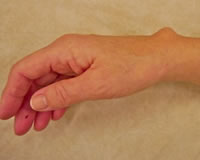Conditions Treated
Ganglions
What are they?
Ganglions are swellings that occur around the wrist and hand. They account for over 50% of abnormal swellings in the hand.
What causes it?
Ganglions are caused by abnormal "out pouching" of normal tissues that surround the wrist and finger joints. These outpouchings fill with joint (synovial) fluid causing them to swell. Ganglions can sometime be caused by trauma, arthritis or may occur spontaneously for no reason.
What are the symptoms?
The majority of patients present with firm, smooth round swelling from:
- The back of the wrist - these are the most common type of ganglion and usually arise from the back of the wrist joint. They tend to change in size with time and cause pain and discomfort when bending the wrist back.
- The underside of the wrist - less commonly the ganglion arises from the joint between the base of the thumb and wrist. They are generally very close to the radial artery and nerves, so surgery carries higher risk of complications.
- The topside of the last finger joint - more common in elderly patients and due to arthritic changes in the last finger joints of the hand. They may also cause deformity of the overlying nail. Sometimes these cysts become red, inflamed and infected.
- The underside of the base of the finger - Known as a pearl ganglion, these small, firm ganglions often cause a sharp, catching pain when using the hand to grip objects.
Do I need any further investigations?
Not usually. Most ganglions can be diagnosed clinically, however difficult or unusual cases may require an ultrasound scan or MRI to confirm the diagnosis and highlight the surrounding anatomy.
What is the treatment?
The natural history of the majority of ganglions is that will change in size and shape with time. Many resolve spontaneously but may recur. The old treatment was to hit them with a bible, for no other reason that it was the heaves book people owned; this treatment burst the ganglion but it not recommended!
Some surgeons inject ganglions but Andy feels the results are unsatisfactory so rarely does this.
Patients who have persistent, painful and unsightly ganglions generally require surgical excision of the lesion. Sometimes one of the small nerves that supplies the sensation to the capsule of the wrist is excised at the same time; this helps to relive some of the pain. Depending on the size and site of the lesion the operation is carried out under a local or general anaesthetic as a day case procedure.
How long will it take to recover?
Depending on the size and site of the lesion and the surgery performed recover can take from 7-14 days. A bandage dressing will be applied to the hand/ wrist after the operation. You will be seen by a hand therapist at 2 days who will remove this, clean and redress the wounds for you. The hand therapist will get you moving your hand very early after surgery to avoid stiffness.
The stiches are removed at around 10 days and Andy will review you at that point.
Following your 2 week appointment your hand therapist will get you moving your hand more and more and will also advise how to help soften and desensitize the scars.
What are the potential complications?
Any surgical procedure carries risks, however every effort is made to minimize these to ensure the best possible outcome from your surgery.
- Infection - Uncommon and usually treated very successfully with antibiotics
- Delayed healing - Smokers and those with diabetes are more prone to this
- Painful/Tender Scars - the vast majority of patients complain of some discomfort around the scar and thumb, this is know as pillar pain and generally resolves with time. Rigorous wound care and desensitization as directed by your hand therapist help prevent this.
- Recurrence - depending on the location of the ganglion, literature quotes a recurrence rate of around 15-20%. Mr. Hacker will discuss this with you at the time of your consultation.
- Stiffness - Operations to the hand may cause stiffness, this can be minimized by working closely with your hand therapist and getting your hand moving as early as possible.
- CRPS - An uncommon but potentially serious complication of hand surgery leading to pain, swelling and discomfort. It is impossible to predict this problem but working closely with you hand therapist and getting your hand moving early has been proven to significantly reduce the risk of this.
When can I get back to normal activities?
The hand MUST be kept clean and dry for 10 days until the sutures are removed. Depending the site and extent of your surgery you should be able to return to "desk job" type activities within 1 week of the operation. Any manual work, heavy lifting or sporting activities should be avoided for at least 4-6 weeks.
You may return to driving in around 1-2 weeks. Please inform your insurance company that you have recent hand surgery to ensure that are happy for you to do so.

